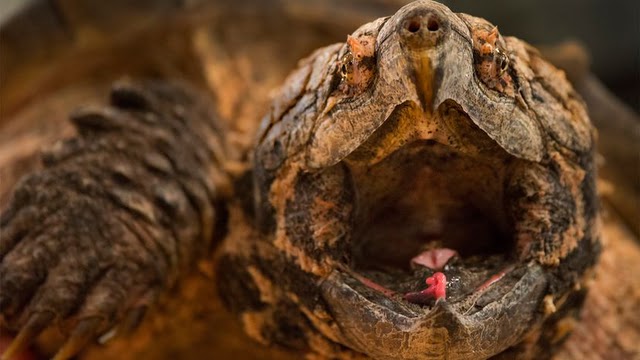Quck answer
Alligator snapping turtles use a worm-like tongue appendage to lure their prey. They sit at the bottom of rivers and lakes with their mouths open, wiggling their tongues to attract fish. When a fish comes close enough, the turtle snaps its jaws shut with incredible force, thanks to its strong muscles and sharp beak. These turtles are the largest freshwater turtles in North America and can weigh up to 200 pounds. They are also incredibly long-lived, with some individuals living for over a century. Unfortunately, they are at risk of extinction due to habitat loss and over-harvesting for food and the pet trade.
Wild Animals

The alligator snapping turtle, which is the largest freshwater turtle in North America, has a unique way of catching prey. It uses a wriggling worm-like tongue appendage to lure fish into its jaws. Despite its reputation for being able to split broomsticks in half with its powerful bite, the alligator snapper is not usually aggressive towards humans.
Alligator Snapping Turtle vs. Common Snapping Turtle
The alligator snapping turtle’s smaller cousin, the common snapping turtle, is much smaller and can be found in the northern and eastern regions of North America. The alligator snapper is sexually dimorphic and the largest males can grow up to 31.5 inches in shell length, making them some of the biggest freshwater turtles in the world. Both species have prehistoric appearances and unique features, but the alligator snapper is the only one with prominent ridges on its upper shell.
Distribution
The alligator snapping turtle is a southern species and is mainly found in bodies of water that drain into the Gulf of Mexico.
The distribution of alligator snapping turtles has been questioned, as new research suggests that there are actually three distinct species within the Macrochelys genus. While experts previously believed that alligator snappers only resided in certain areas of the US, a 2014 study found that turtles in the western, central and eastern regions of this range were genetically different from one another. The newfound species have been named Macrochelys suwanniensis and Macrochelys apalachicolae, and conservationists fear that having to protect three geographically confined species could complicate conservation efforts. Alligator snappers are semiaquatic and mostly remain underwater, where they forage for plants, fruits, seeds, and prey including other turtles, amphibians, and even wood ducks, muskrats, beavers, and young crocodilians. Their dietary cornerstone is fish, which they lure in with a blood-filled appendage on their tongue that resembles a worm. Although hatchlings and juveniles have many predators, adult alligator snappers only have humans to fear and can live for several decades.
FAQ
1. What is an Alligator Snapping Turtle?
An Alligator Snapping Turtle is a large freshwater turtle known for its unique appearance and behavior. They can weigh up to 200 pounds and have a distinctive ridged shell and a large head with a hooked beak. They are found in rivers, lakes, and swamps in the southeastern United States.
2. How does the Alligator Snapping Turtle catch its prey?
The Alligator Snapping Turtle uses a unique method to catch its prey. It has a worm-like tongue appendage that it wiggles in the water to attract fish and other small animals. When the prey gets close enough, the turtle snaps its powerful jaws shut, trapping the prey inside.
3. Why is the Alligator Snapping Turtle important to its ecosystem?
The Alligator Snapping Turtle is an important part of its ecosystem. They help to control the populations of fish and other aquatic animals, which helps to maintain a healthy balance in the ecosystem. They are also an indicator species, meaning that their presence or absence can indicate the health of the ecosystem.
4. Are Alligator Snapping Turtles endangered?
Yes, Alligator Snapping Turtles are considered a threatened species. They are often hunted for their meat and shells, which has led to a decline in their populations. Habitat loss and pollution are also major threats to their survival.
5. How can we help protect the Alligator Snapping Turtle?
There are several things we can do to help protect the Alligator Snapping Turtle. We can support conservation efforts and laws that protect them from hunting and habitat destruction. We can also reduce pollution and protect their habitats by supporting wetland conservation efforts. Finally, we can educate others about the importance of these turtles and the role they play in their ecosystems.





Leave a Reply